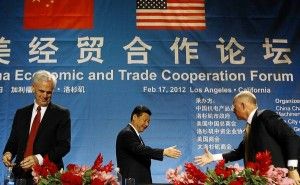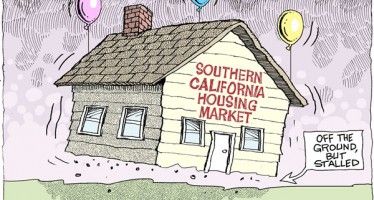Gov. Brown seeking funding for CA bullet train
By Wayne Lusvardi
Why did Gov. Jerry Brown travel to China on a trade mission to secure investment from them for the California High Speed Rail Authority?
The answer is that proposed public transportation projects keep chugging along because of subsidies and cost shifting that can be generated through political deals.
The bullet-train project has run into financial trouble because the state can’t afford any more of its bonding capacity for the project beyond the $9.95 billion from Proposition 1A, the 2008 initiative voters passed. Voters are highly unlikely to approve more bonds for the project. Additionally, private U.S. investment markets are reluctant to invest in such an obviously unprofitable venture.
As shown in the table below from the U.S. General Accounting Office, the project would generate no effective positive cash flow and needs an infusion of $13.1 billion of private capital to be economically feasible. The project would be even more shaky if there were cost overruns typical of most large government public-works projects.
California High Speed Rail Funding Sources
| Funding Source | Total In Billions of Dollars | Percent Total |
| PUBLIC FUNDING | ||
| Federal | $42.0 | 61% |
| State high-speed rail bond | $8.2 | 12% |
| Locally generated | $5.0 | 7% |
| Subtotal Public Funding | $55.2 | 81% |
| PRIVATE FUNDING AND CASH FLOW | ||
| Private investment | $13.1 | 19% |
| Operating cash flow | $0.2 | 0% |
| Subtotal private funding and cash flow | $13.3 | 19% |
| Grand Total | $68.5 | 100% |
| Source: U.S. Government Accountability Office (GAO), Preliminary Assessment of California’s Cost Estimate and Other Challenges, Dec. 6, 2012. | ||
Borrowing
But why would California seek Chinese investment and why would China be remotely interested?
One reason: California is seeking China to be an investor because the U.S. Treasury is dependent on borrowing from China. China could be recompensed by the U.S. Treasury for investing in California’s bullet train by paying a slightly higher interest rate on bonds sold to China. Moreover, the U.S. Congress would be less likely to cut any future subsidies to the bullet train. The federal government already has pledged to spend $3.5 billion on the project.
California unsuccessfully sought to use $1 billion of annual funds generated from its Cap and Trade pollution permit auctions to pay for green power to run its high-speed trains.
If California could alternatively secure an annual transportation subsidy from Congress to operate the train, this could serve as an indirect subsidy to green power companies and to its regulated electric utilities that have a green power mandate. This funds transfer would be a federal transportation subsidy indirectly subsidizing California’s green power mandate. It would be a “subsidy subsidizing a subsidy” — also known as an indirect fund transfer that would shift costs from state taxpayers to federal taxpayers.
But the Republican-controlled U.S. House of Representatives has been reluctant to pop for any such subsidies.
China takes a financial bullet?
But suppose the House did go along, perhaps after switching to Democratic control after the 2014 election? China could cut a more favorable deal with the Obama-run U.S. Treasury in return for investing in California’s bullet train. The U.S. borrows $120 billion from China each year, or $10 billion per month. And, in turn, the U.S. Congress might approve transportation subsidies to California’s Bullet Train.
China would appear to be taking a bullet in the head if it invested in California’s High Speed Rail Authority. But in the complex world of public financing, China may be willing to sink money into a loser bullet train project if it were to get a premium on its purchase of bonds from the U.S. Treasury.
Yet even this scenario seems implausible. While Brown was in China, an independent study by the Reason Foundation found that bullet train ridership is way overestimated and a trip from San Francisco to Los Angeles would take a slow 4 hours, much more than the 2 hours and 40 minutes promised to voters by Prop. 1A.
This comes only four months after the U.S. Government Accountability Office study mentioned above, which found the train ould generate effectively no profits and was based on inflated assumptions.
It is hard for the average voter to understand why China would invest in a project with negative cash flow because it is so irrational on its face. The Chinese, who have re-learned capitalism fast after dumping Maoist communism in 1979, also are unlikely to make sense of funding the project.
Related Articles
San Francisco approves ‘coercive’ green energy plan
Sept. 21, 2012 By Dave Roberts Thousands of San Francisco residents may be sucked into a green energy plan that
CA Green Elites Block Economic Recovery
JULY 21, 2011 By WAYNE LUSVARDI In 1970, Tom Wolfe wrote a non-fiction book titled “Radical Chic and Mau-Mauing the
Housing report by Legislative Analyst raises affordability questions
The California Legislative Analyst’s new report on housing costs puts numbers to what housing-hunters know on the ground: affordable housing




